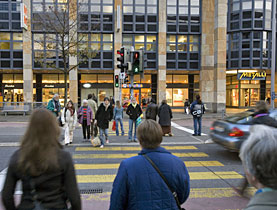
Switzerland rates poorly in pedestrian safety

More pedestrians are killed on Swiss roads than the European average, but traffic organisations do not agree on what should be done.
The results of a study of 16 European countries carried out by the Touring Club of Switzerland (TCS) revealed a poor performance by Switzerland concerning road safety.
In 2006 a total of 370 people died on Swiss roads, a fifth of them pedestrians. Of those a quarter were killed on zebra crossings.
At 20.5 per cent, the number of pedestrians killed as part of the total Swiss road deaths was significantly higher than the European average of 14.6 per cent, the study found. Only Britain did worse, with 21.3 per cent.
In addition, the 5.4 per cent of Swiss road victims who lost their lives at zebra crossings was more than double the European average of 2.3 per cent. In Switzerland this corresponds to 2.7 people per million inhabitants.
The TCS said these figures showed action was needed in Switzerland to protect pedestrians at zebra crossings. It was important, it said, to spend time discussing the design of pedestrian crossings, adding that good visibility – day and night – was essential.
In addition to preventive measures and penalties for those who break the rules, the TCS is also calling for sound road education.
“People should be made more aware that pedestrian crossings are not automatically safe zones,” said TCS spokesman Stephan Müller.
Speed restrictions?
However, the Swiss Transport and Environment Association says the solution to saving lives lies elsewhere.
“The most effective way of protecting the most vulnerable people road users is lowering speed limits – right next to schools, residential and built-up areas and tram and bus stops,” said Christine Steinmann, the association’s project leader for road safety.
Speed restrictions result in fewer fatal accidents involving pedestrians, she said.
But the TCS dismisses a general reduction in speed limits. “There’s no point,” Müller said. “What’s needed is simply more discipline and care – from pedestrians as well as from drivers.”
He said it was too one-sided to point the finger solely at motorists. “Pedestrians can’t simply stroll out onto the zebra crossing,” he said, adding that the Tempo 30 scheme – locally imposed speed limits of 30km/h in residential areas – didn’t make the roads safer because it was poorly observed.
Too general
Steinmann rejects the notion that Swiss drivers are more aggressive than those in other countries, but says in most cases the driver is to blame for pedestrian deaths.
“If motorists drive too fast, the [pedestrian’s] right of way is disregarded,” she said.
She said the study confirmed that pedestrians were at risk in Switzerland and in other countries but she thought it was too general.
“If you analyse the various factors individually, Switzerland’s position isn’t so bad,” she said.
Two-thirds of pedestrians killed in Switzerland are pensioners. Steinmann says the study should therefore factor in the age demographics in the respective countries.
Also, how often someone spends on the road plays an important role, she says. Swiss pedestrians cover an average of 1.5km a day.
Cooperation
The TCS has no specific plan for reducing the number of pedestrians killed on Swiss zebra crossings.
“There are so many pedestrian crossings in Switzerland that normally people don’t cross the street other than at a pedestrian crossing,” Müller said
Regarding pedestrians having the right of way, he said: “The TCS is not against it and is not calling for a change in the law. However tighter controls are necessary.”
Despite differences in opinion, the Swiss Transport and Environment Association is pleased with the TCS’s commitment.
“We’re happy whenever the TCS supports us to protect the most vulnerable road users,” Steinmann said.
“Until now that has not always been the TCS’s major concern.”
swissinfo, based on an article in German by Corinne Buchser
The early 1970s were the worst years for road accidents in Switzerland when the annual average was around 35,000. The Swiss population is now 7.5 million.
The highest number of road fatalities was also registered during this period, with a record 1,773 deaths in 1971.
The number killed in road accidents has been declining steadily since 1995, when nearly 700 people died.
The number of road deaths per million people in Switzerland in 2006 was 49, compared with 62 in Germany, 74 in France, 88 in Austria and 92 in Italy.
(Translated from German by Julia Slater)

In compliance with the JTI standards
More: SWI swissinfo.ch certified by the Journalism Trust Initiative



























You can find an overview of ongoing debates with our journalists here . Please join us!
If you want to start a conversation about a topic raised in this article or want to report factual errors, email us at english@swissinfo.ch.